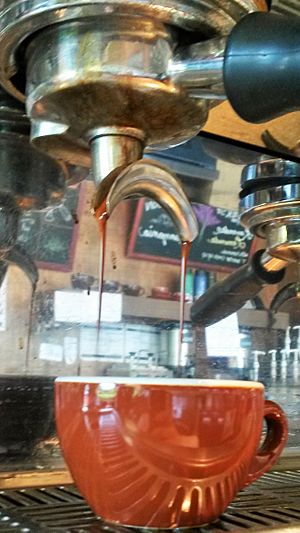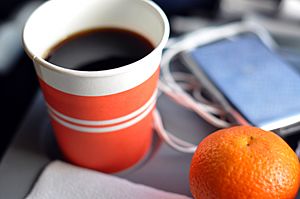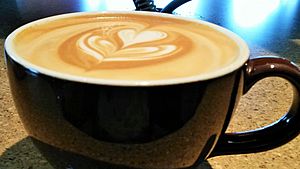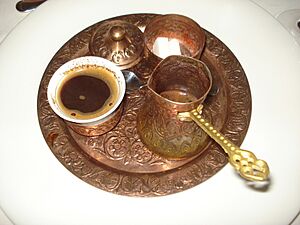Coffee cup facts for kids

A coffee cup is a special container for serving coffee and drinks made with espresso. Most coffee cups are made from ceramic material that has a shiny glaze on it. They usually have a single handle so you can hold them easily, even when the drink inside is hot. Ceramic cups are great because they keep your drink warm and can be washed quickly with cold water without breaking, unlike regular glass glasses.
Sometimes, coffee cups are made to be used only once and then thrown away. These are called disposable cups. They can be made from paper or polystyrene foam. Coffee shops often use paper cups for customers who want to take their drinks to go. They might also add a coffee cup sleeve to protect your hands from the heat.
More and more people are choosing reusable coffee cups instead of disposable ones. This is a more eco-friendly way to enjoy coffee. These reusable cups can be made from materials like bamboo, polypropylene, or even plant-based materials like starch and paper pulp. Studies show that very few single-use cups are actually recycled. This has encouraged many people to look for better options.
History of Coffee Cups
In the past, coffee cups were made from many different materials. People used carved bone, clay, wood, strong glass, metal, and fine porcelain.
Coffee Cup Lids: A Modern Invention
Most coffee cup lids are made of plastic. The very first design for a coffee cup lid was patented in 1967. It was designed to fit tightly on the cup to stop leaks and had a small hole for steam to escape. However, you had to tear the lid to drink from it.
In 1986, the Solo Traveler lid was invented. This lid is so famous that it's even been shown in a museum! Newer lid designs, like the Viora, have improved on the Solo Traveler. They make it easier to drink by allowing more air to enter. Experts say that coffee cup lids show a big change in how Americans enjoy "to-go" drinks.
Coffee Cup Shapes and Sizes

Coffee cups come in many different shapes and sizes, especially in cafes. These sizes often match the sizes of paper cups. Even people who travel a lot have special cafe cups. Common sizes are about 225 ml, 336 ml, 460 ml, and sometimes 570 ml. While sizes can vary a little between coffee shops, these are the usual standards.
These cups are used for popular coffee drinks like mochas and lattes. Many are made of porcelain and shaped to help baristas create beautiful latte art on top of your drink.
Cappuccino Cups

A cappuccino is usually served in its own special cup. This is a 171 ml porcelain cup that comes with a matching saucer. The size of the cup is perfect for a traditional cappuccino. This drink has equal parts of espresso, steamed milk, and foamed milk.
Demitasse Cups for Espresso
The demitasse is a small cup made especially for espresso. It holds about 60-80 ml of liquid and is usually served on a saucer. A macchiato, which is an espresso shot with a touch of steamed milk, is also served in a demitasse.
Gibraltar or Cortado Glasses
Some coffee shops serve a cortado in a 4-ounce Libbey Gibraltar glass. They often call this drink a "Gibraltar."
Space Cups: Coffee in Space!
NASA even designed special "Space Cups" for astronauts on the International Space Station. These cups are made using 3D printing. Before these cups, astronauts had to drink liquids by sucking them out of a bag! The Space Cup has a unique inner corner that helps the liquid flow right to the astronaut's lips. This happens because of something called capillary flow.
The information learned from using Space Cups can help improve how fluid systems work in space. This includes things like toilets, oxygen systems, and water coolers. This knowledge can also help us design better fluid systems here on Earth, such as portable medical devices for testing infectious diseases.
Materials Used for Coffee Cups

Porcelain Cups
Porcelain is a material that helps keep coffee warm and preserves the "crema." Crema is the lovely foam that forms on top of an espresso shot. Keeping the crema helps create beautiful latte art in milk-based espresso drinks. However, porcelain can cool down quickly because of tiny air bubbles inside the cup material.
Ceramic Cups
Ceramic is a general term for many clay materials, but it doesn't include porcelain. It's a stronger material than porcelain. Because ceramic cups are usually thicker, their walls keep heat better. Ceramic is a good choice when you need a coffee cup that is tough and won't get damaged easily.
Paper Cups
Paper cups often have a special lining of wax or plastic to stop them from leaking. The famous Anthora paper cup, designed in 1963, is a well-known symbol of daily life in New York City.
However, paper cups lined with plastic are not great for the environment. Even if some composting places accept them, they can break down into tiny plastic pieces. These pieces can pollute the environment. This plastic doesn't break down naturally and can be very hard to clean up once it spreads. Also, studies show that paper coffee cups can release tiny microplastic particles into your drink because of their plastic lining.
Bamboo Cups
Bamboo coffee cups are often advertised as "natural" products. But they are actually made from powdered bamboo fibers mixed with a glue that contains melamine and formaldehyde. Some consumer groups, like Stiftung Warentest in Germany, are worried that these substances could be harmful when used with hot drinks.
Polystyrene Cups
Polystyrene, sometimes called styrofoam, is used mostly because it's very good at keeping drinks hot or cold. However, using polystyrene for coffee cups and other containers is a debated topic. It doesn't break down naturally, it's a big source of trash in the ocean, and it's hard to recycle. There are also some health concerns linked to it.
Many cities in the U.S., like Portland, San Francisco, and Amherst, have banned polystyrene food and drink containers. More cities are thinking about doing the same. The doughnut and coffeehouse chain, Dunkin' Donuts, has been criticized for still using styrofoam cups. They have said that no other material insulates as well. However, they have started to use double-walled paper cups that look like their old foam cups.
Coffee Cup Sleeves
Coffee cup sleeves are like cardboard rings that fit tightly over paper coffee cups that don't have handles. They protect your hands from the hot coffee inside. Jay Sorensen invented and patented the coffee sleeve in 1993. Now, coffee shops and other places that sell hot drinks in disposable paper cups use them all the time. Coffee sleeves are usually made from textured paperboard, but you can find them made from other materials too.



